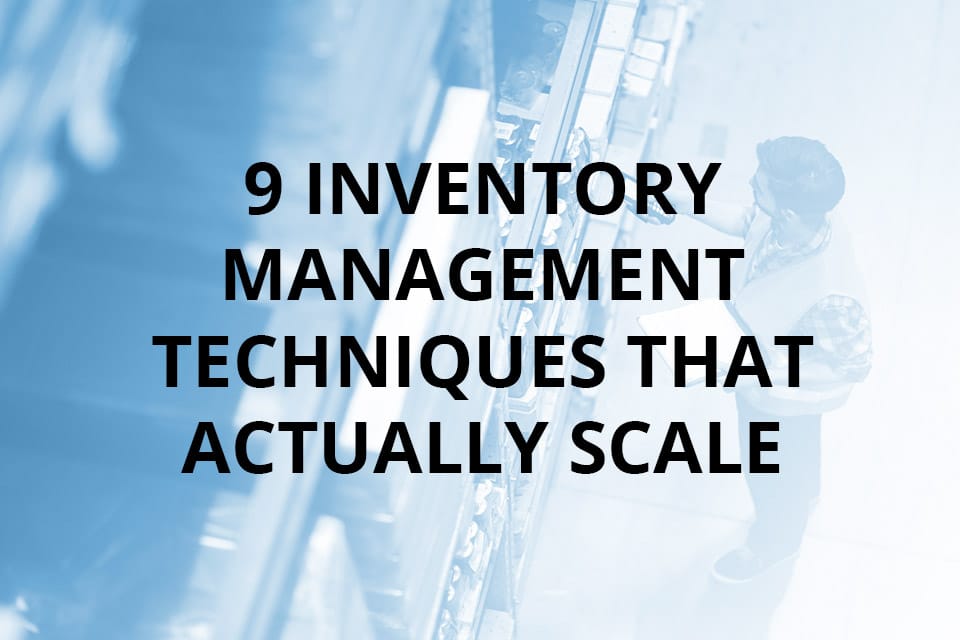
No matter the size of your business, managing inventory is a daunting task. Human error or a technological malfunction could lead to a miscount, which might cause you to over- or under-order, leaving you with insufficient products. Proper inventory management is vital to keep your stock moving and customers returning. To ensure that your business runs smoothly and efficiently, several techniques and tools are at your disposal to keep your information in line.

Effective Inventory Management Techniques
Spreadsheets are a thing of the past. Simply counting inventory will not show you how much you sell or how fast you sell it. Instead, these techniques will give you perspective on what consumers are buying and what products are wasting space in storage.
1. First-In, First-Out (FIFO)
FIFO means that the first stock to arrive is the first to go out on display. This is one of the most vital inventory management techniques for food items that prevents your products from expiring in storage before they reach shelves. However, following FIFO for non-food items that can become out-of-season is also beneficial. A FIFO system can help you move seasonal merchandise easier and can help you avoid excessive depreciation of old merchandise.
2. Set Par Levels
Setting a par level will ensure that you never run out of a product. When one product’s inventory reaches par level, you will know to order more. Since not all inventory will be equally in-demand, different par levels for each product will allow you to gauge which stock demands more storage space. Par levels can be more expensive to operate, as you’ll have more inventory on-hand than if you operated a purely JIT strategy, but you’ll be in a better position to cope with demand shocks or shortages.
3. Scheduled Audits
Scheduled audits of your inventory can provide you with insight into your business. An audit can tell you about the health of your business’s finances, including profits and losses, and information about the flow of inventory. You won’t really know the state of your business or what to improve until you conduct an audit of your inventory. Most businesses audit their sales annually to keep track of their inventory, but you can do this as often as you’d like.
4. Cycle Counting
Cycle counting is a form of an audit that occurs on a more regular basis than an annual audit. This involves counting how much inventory you have of one item at a time on a rotating cycle. For example, one day you count apples and the next day oranges so that you can be aware of discrepancies sooner than if you counted everything at the same time only once a year. With cycle counting, you don’t have to count the entirety of your inventory to get a sense of what you have in-stock, making this ideal for companies with larger inventories.
5. ABC Analysis
ABC analysis is a form of cycle counting that involves categorizing inventory based on the Pareto principle, which estimates that 80% of the value of your sales is generated by 20% of your goods. An ABC analysis tells you how much of a product you sell and how much it costs to store. A-items would include bestsellers, B-items are your regularly sold items that are more expensive than A-items, and C-items are the rest. However, you first need to identify the A-, B-, and C-items in your inventory to conduct this analysis.
6. Just-In-Time Inventory
Just-In-Time (JIT) inventory eliminates the need for storage space by providing you with just enough inventory for your consumer demands. As soon as the shipment arrives, it goes on display. In the case of ecommerce fulfillment, an item will ship as soon as it’s ordered and a replacement will be sent to take its place at the warehouse. While JIT inventory management techniques have come under criticism as a result of supply crunches during the pandemic, they remain the most efficient way that producers have to deliver their products to consumers.
7. Inventory KPIs
Inventory KPIs are inventory management techniques that let you set benchmarks and track the performance of your inventory. You can use sales KPIs, such as inventory turnover ratio or the stock to sales ratio, to set benchmarks for sales of your entire stock or particular items. Receiving KPIs lets you track how efficiently your business receives returned items and puts them back into your inventory. Lastly, operational KPIs measure how effective your business is at fulfillment processing – and can tell you when you need some help.
8. Forecasting
We can’t see into the future yet, but logistics forecasting is one of the inventory management techniques that comes pretty close. By estimating via previous records how much of a certain item will sell, you can decide how much inventory to order. Forecasting isn’t a 100 percent accurate form of stock management, but your educated guess will be less likely to lead to over- or under-stocking than blindly choosing.
9. Bundling
Dead or slow-moving inventory can eat up your profit margins in storage costs. Fulfillment warehouse space isn’t cheap, and over time, the cost to store an item can become more than the value of the item itself. If some of your stock has lain dormant in storage for a while, consider bundling those items together. Your customers will feel as though they have been offered a deal by paying less for each item while you still make a profit and clear out the extra inventory.
Related: The 2 Types of Inventory Management Processes (Plus Implementation)
Top Tools for Inventory Management
While all these techniques may sound simple, applying them to your business might be a little more difficult. Thankfully, there are plenty of tools at your disposal to keep you organized.
1. Point-of-Sale (POS)
Many POS systems work with your inventory systems to update inventory data. Software from Shopify and Square are just two examples.
2. Information Dashboard
Dashboards for your inventory statistics are useful in that you visually see the divide between your items. Activate offers a customizable dashboard to fit your needs.
3. Reorder Alerts
Also known as “low stock alerts.” Many inventory software products include a tool that alerts you when items run low and need to be replenished.
4. Barcode Tracking
Having a barcode system will allow for faster and more efficient inventory counts and audits.
5. Lot Tracking
While lot tracking is not necessarily a crucial tool for everyone, being able to track your inventory as it makes its way from the manufacturer to you can be beneficial when you need to ship products to customers or send them back due to recall.
6. Inventory Reports
With a tool to run reports, you gain insight into which products are moving and how quickly they sell. That way, you can proactively adjust your par levels.
7. System Integrations
You’ll want software that can integrate your current inventory system with your other management systems, such as accounting software. Activate and Stitch are two of many capable of this.
8. Shipping
When selling online and shipping to customers, the ability to not only track the order but also account for the sold merchandise in your inventory is useful.
9. Multi-Location Inventory
For larger companies with multiple locations, you will want software that can update inventory counts everywhere.
10. Transfer Orders
While keeping track of general inventory across all locations is important, being able to transfer orders from one location to another is just as handy. This way, inventory counts automatically update for both locations.
11. Stocktakes
This tool will help you perform your inventory counts, whether or not your stock uses barcodes.
12. Cloud-Based Systems
Software synced to the cloud allows you to connect to your system and adjust inventory even when you’re out of office. Constant access will allow you to mollify any issues more promptly.
Ship My Orders’ Inventory Management
As your business grows, so will your inventory demands. Choosing the right fulfillment partner to help you manage them is essential for keeping your customers satisfied and maintaining growth. At Ship My Orders, we offer a suite of order fulfillment and storage warehousing services that are designed to scale with your business and demand. We use the latest technologies, including an inventory management system, along with caring and dedicated customer service to manage your inventory and ensure it gets to the right customers the first time.
Take Advantage of The Best Inventory Management Techniques By Choosing Ship My Orders
Inventory management allows you to spot inefficiencies in your supply chain and fix them before they severely eat into your margins. However, it’s one thing to know you need to do ABC testing or to implement inventory management systems, and another to carve time out to actually follow through. That’s where we come in.
At Ship My Orders, we have years of experience in serving as a dedicated third-party logistics partner for growing businesses around the world. Let us use our expertise to help your business stay ahead on top of your inventory’s demands, not buried under them. Contact us today for more information!


-1.png)


